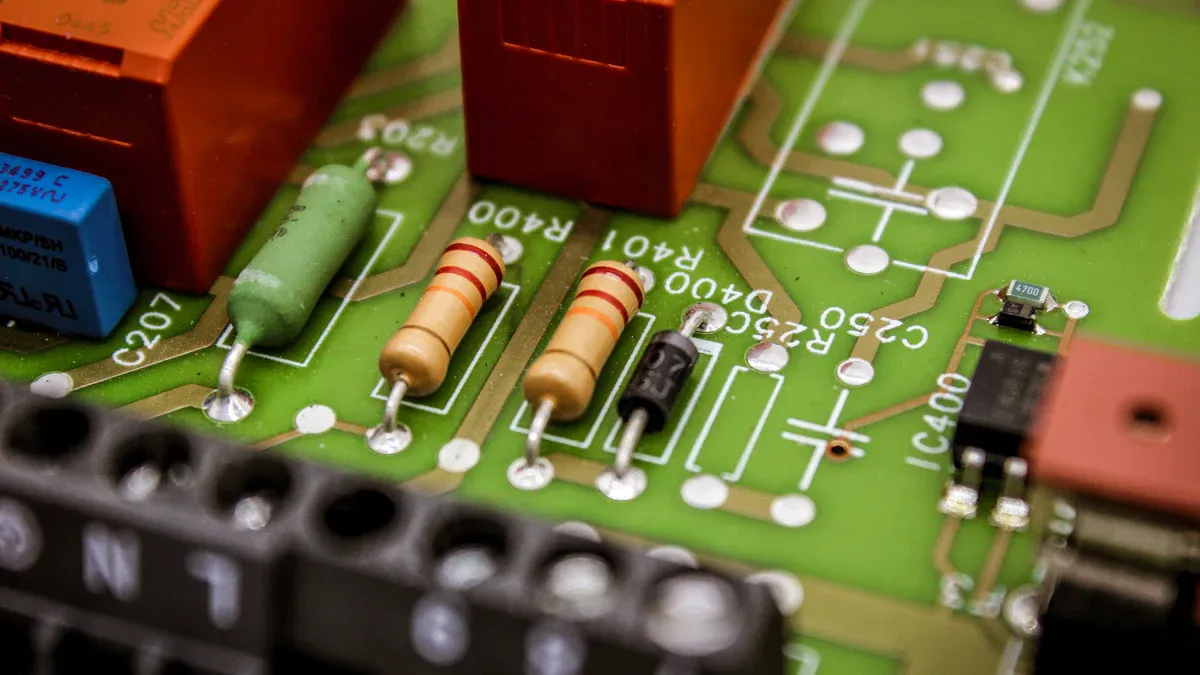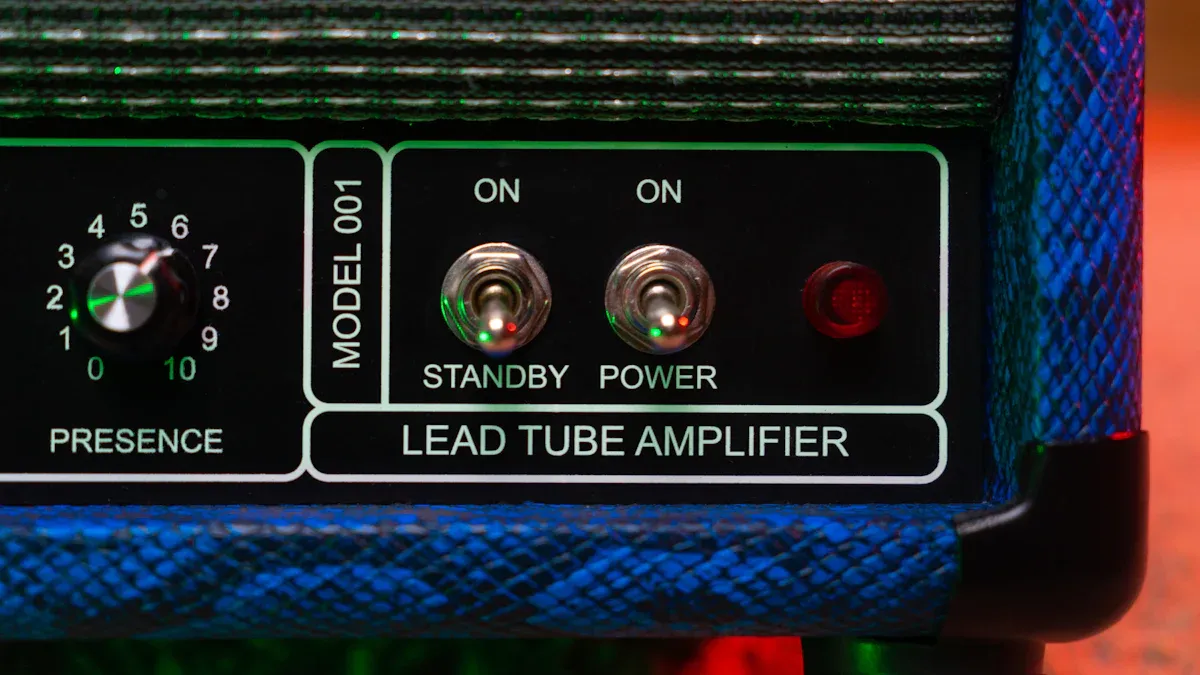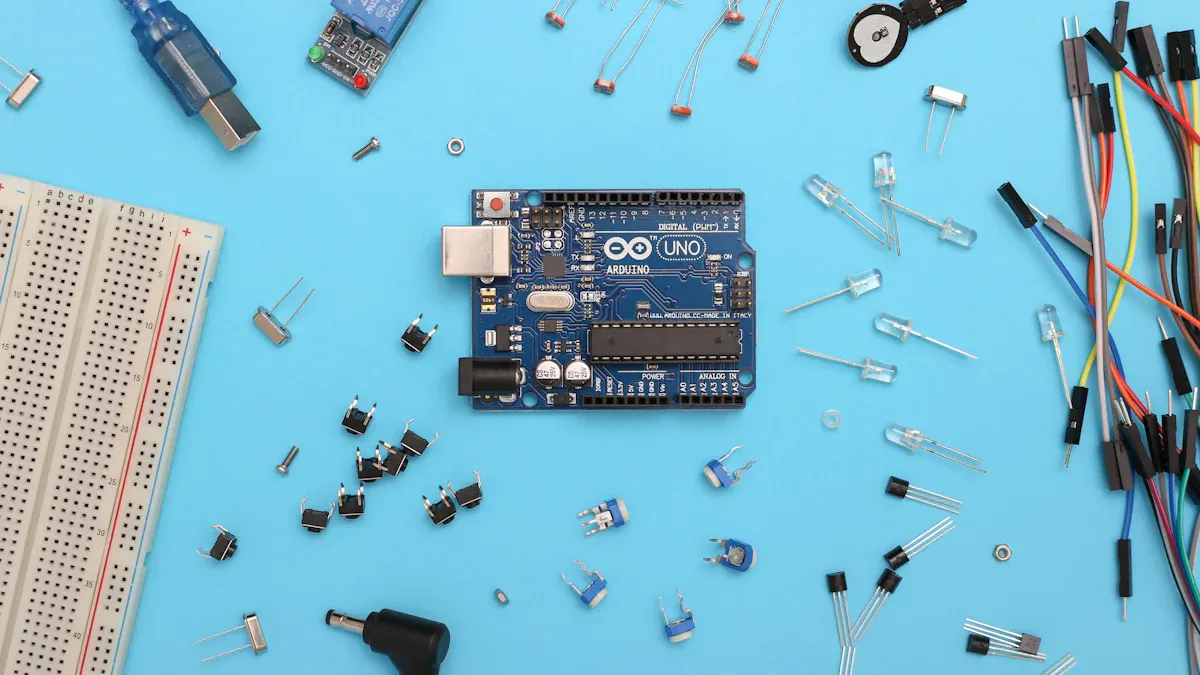Discover the ADL5561ACPZ-R7 Performance and Features

The ADL5561ACPZ-R7 serves as a crucial component in radio frequency (RF) applications. Its robust performance metrics and unique features make it a preferred choice among engineers and designers. Understanding its capabilities is essential for optimizing RF system designs. This device not only enhances signal integrity but also supports various applications, making it a valuable asset in the field of electronics.
Key Takeaways
The ADL5561ACPZ-R7 offers flexible gain settings of 6 dB, 12 dB, and 15.5 dB to fit different RF needs.
It delivers low noise and ultralow distortion, ensuring clear and strong signals in sensitive applications.
This device uses low power, making it perfect for battery-powered and energy-saving designs.
Its compact size allows easy integration into tight spaces without losing performance.
The ADL5561ACPZ-R7 works well in many areas like wireless communication and high-speed data conversion.
ADL5561ACPZ-R7 Performance

Gain and Bandwidth
The ADL5561ACPZ-R7 excels in gain and bandwidth, making it suitable for various RF applications. This device offers configurable gain options of 6 dB, 12 dB, and 15.5 dB, allowing engineers to tailor performance to specific needs. The operational frequency range spans up to 2.0 GHz at a 6 dB gain, ensuring compatibility with high-frequency signals.
The following table summarizes key performance metrics related to gain and bandwidth:
Parameter | Details |
|---|---|
Operational Frequency Range | Bandwidth of 2.0 GHz at 6 dB gain |
Gain Options | 6 dB, 12 dB, 15.5 dB (pin configurable) |
Noise Performance | Input noise as low as 2.1 nV/√Hz (at 12 dB gain) |
Distortion Performance | Maintains ultralow distortion (e.g., HD2 < -90 dBc at 10 MHz) over wide frequency range |
Impact on Performance | Supports high-frequency RF/IF applications, drives high-speed ADCs, ensures high linearity and signal integrity |
Typical Applications | Wireless communications, instruments, audio equipment, industrial control |
Noise Figure and Distortion
The noise figure of the ADL5561ACPZ-R7 is another critical performance metric. With an input noise level as low as 2.1 nV/√Hz at a gain of 12 dB, this device ensures minimal signal degradation. Such low noise performance is essential for maintaining signal integrity in sensitive applications.
In terms of distortion, the ADL5561ACPZ-R7 demonstrates impressive characteristics. It maintains ultralow distortion levels, with harmonic distortion (HD2) measured at less than -90 dBc at 10 MHz. This performance is crucial for applications requiring high linearity, such as RF communication systems and high-speed data converters.
Overall, the combination of configurable gain, wide bandwidth, low noise figure, and minimal distortion makes the ADL5561ACPZ-R7 a standout choice for engineers looking to optimize their RF designs.
ADL5561ACPZ-R7 Features

Low Power Consumption
The ADL5561ACPZ-R7 stands out for its low power consumption, making it an ideal choice for battery-operated devices and energy-sensitive applications. This feature allows engineers to design systems that require less energy without compromising performance. The device operates efficiently, consuming only 150 mW at maximum gain. This efficiency translates into longer battery life and reduced heat generation, which is crucial for maintaining system reliability.
High Linearity
High linearity is another significant feature of the ADL5561ACPZ-R7. This characteristic ensures that the amplifier maintains signal integrity across a wide range of input levels. Several design features contribute to this high linearity:
Low broadband distortion at various gain settings
Very low harmonic distortion levels, such as −94 dBc for HD2 and −87 dBc for HD3 at 10 MHz
A differential or single-ended input to differential output architecture
Pin-strappable gain adjust options (6 dB, 12 dB, 15.5 dB) for flexible gain control
A fast slew rate of 9.8 V/ns and a fast settling time of 2 ns, minimizing distortion during signal transitions
Fabrication using the high-speed XFCB3 SiGe process, enhancing both speed and linearity performance
These features collectively ensure that the ADL5561ACPZ-R7 delivers exceptional performance in demanding RF applications.
Compact Design
The compact design of the ADL5561ACPZ-R7 further enhances its appeal. With a small footprint, this device allows for easy integration into various circuit layouts. Engineers can utilize the space-saving design to create more compact and efficient systems. The small size does not compromise performance; instead, it provides flexibility in design while maintaining high functionality. This aspect is particularly beneficial in applications where space is limited, such as portable devices and densely packed circuit boards.
Applications of ADL5561ACPZ-R7
RF Communication Systems
The ADL5561ACPZ-R7 plays a vital role in RF communication systems. Its performance characteristics significantly enhance signal integrity and system efficiency. The device features a low noise input stage of 2.1 nV/√Hz at a gain of 12 dB, which minimizes signal degradation. This capability is crucial for maintaining clarity in communication signals.
The following table summarizes key performance aspects that make the ADL5561ACPZ-R7 ideal for RF applications:
Performance Aspect | Specification / Feature |
|---|---|
Noise | Low noise input stage: 2.1 nV/√Hz (RTI at 12 dB gain) |
Distortion | Low broadband distortion; IMD3 of −86 dBc at 250 MHz |
Gain Levels | Pin-strappable: 6 dB, 12 dB, 15.5 dB; flexible gain 0-15.5 dB |
Bandwidth | −3 dB bandwidth of 2.9 GHz (at 6 dB gain) |
Slew Rate | Fast slew rate of 9.8 V/ns |
Settling Time | Fast settling time of 2 ns |
Power Consumption | Low supply current: typically 40 mA; <3 mA when disabled |
Process Technology | High speed SiGe process |
These features collectively enhance signal integrity, reduce noise and distortion, and improve overall system linearity and speed in RF communication deployments.
High-Speed ADC Driving
The ADL5561ACPZ-R7 serves as an excellent driver for high-speed ADCs. This device is designed specifically for high-speed applications, featuring three independent channels with adjustable gain and output voltage. This flexibility allows for optimal signal conditioning before ADC conversion.
Key benefits of using the ADL5561ACPZ-R7 in high-speed ADC driving include:
Support for high driving current, accommodating fast ADC conversion rates.
Operation at frequencies up to 2.9 GHz, suitable for high-frequency signal conditioning.
Low noise characteristics that minimize signal distortion during driving.
Low power consumption, making it ideal for portable devices.
Applications span wireless communication (5G, Wi-Fi), radar, lidar, automotive ECU, and industrial sensor interfaces.
Proper operation requires attention to input signal levels, output load impedance, and thermal management when driving multiple channels at high speed. The compact LFCSP-16 package facilitates easy integration into PCB designs, making the ADL5561ACPZ-R7 a versatile choice for engineers.
Comparison with Similar Products
Competitive Analysis
When comparing the ADL5561ACPZ-R7 to similar RF amplifiers, several key factors emerge. Competitors often include devices like the HMC7044 and the LTC6400. While these products offer competitive features, the ADL5561ACPZ-R7 stands out in several areas:
Gain Options: The ADL5561ACPZ-R7 provides configurable gain settings of 6 dB, 12 dB, and 15.5 dB. This flexibility allows engineers to optimize performance for specific applications. In contrast, some competitors may offer fewer gain settings, limiting design flexibility.
Noise Figure: With an input noise figure as low as 2.1 nV/√Hz, the ADL5561ACPZ-R7 excels in maintaining signal integrity. Many competing products struggle to match this low noise performance, which is critical for sensitive RF applications.
Power Consumption: The ADL5561ACPZ-R7 operates at a low power consumption of just 150 mW at maximum gain. This efficiency is particularly beneficial for battery-operated devices. Other amplifiers may consume more power, leading to shorter battery life.
Advantages of ADL5561ACPZ-R7
The ADL5561ACPZ-R7 offers several advantages that make it a preferred choice among engineers:
High Linearity: The device maintains high linearity across a wide range of input levels. This characteristic ensures minimal distortion, which is essential for applications requiring precise signal reproduction.
Compact Design: Its small footprint allows for easy integration into various circuit layouts. This compactness is especially advantageous in space-constrained environments.
Versatile Applications: The ADL5561ACPZ-R7 is suitable for a wide range of applications, including RF communication systems and high-speed ADC driving. Its adaptability makes it a valuable asset in diverse electronic designs.
The ADL5561ACPZ-R7 stands out as a powerful RF amplifier, offering exceptional performance and versatility. Key highlights include:
Low input noise of 2.1 nV/√Hz at 12 dB gain
Configurable gain settings of 6 dB, 12 dB, and 15.5 dB
Excellent linearity with harmonic distortion HD2 < -90 dBc at 10 MHz
These features make the ADL5561ACPZ-R7 suitable for demanding applications such as 5G wireless communications, radar, and medical imaging. As technology evolves, engineers must consider emerging trends like FPGA-based RF design, which may influence the relevance of traditional amplifiers. Nevertheless, the ADL5561ACPZ-R7 remains a reliable choice for high-performance RF systems.
FAQ
What is the maximum operational frequency of the ADL5561ACPZ-R7?
The ADL5561ACPZ-R7 operates effectively up to 2.0 GHz at a gain of 6 dB, making it suitable for high-frequency RF applications.
How does the ADL5561ACPZ-R7 minimize noise?
This device features an input noise level as low as 2.1 nV/√Hz at a gain of 12 dB, ensuring minimal signal degradation in sensitive applications.
What are the gain options available for the ADL5561ACPZ-R7?
The ADL5561ACPZ-R7 offers configurable gain settings of 6 dB, 12 dB, and 15.5 dB, allowing engineers to tailor performance for specific applications.
How does the ADL5561ACPZ-R7 perform in terms of power consumption?
The device operates at a low power consumption of 150 mW at maximum gain, making it ideal for battery-operated and energy-sensitive applications.
In which applications is the ADL5561ACPZ-R7 commonly used?
Engineers commonly use the ADL5561ACPZ-R7 in RF communication systems, high-speed ADC driving, wireless communications, and industrial sensor interfaces.
See Also
Discovering Key Capabilities of Low Power Offline Switcher Chips
Understanding The Characteristics Of High-Performance Microcontroller Chips
Selecting The Best Low-Power MCU For Your Next Project
Analog Devices Strategies For Maintaining A Robust Chip Supply
An Overview Of IC Audio Signal Processors And Their Functions
